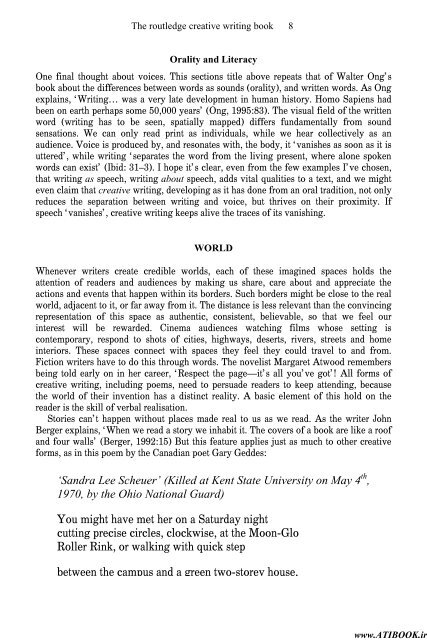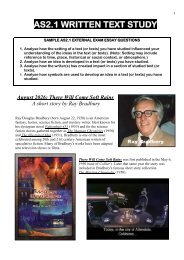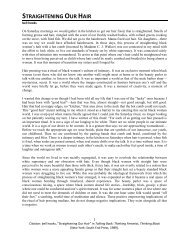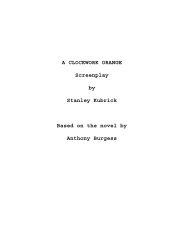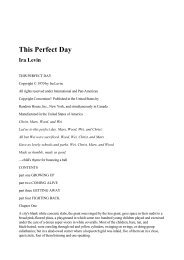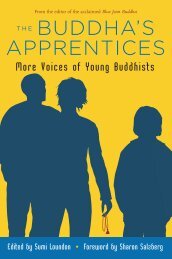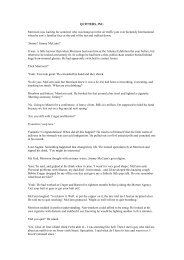9780415317856_the_routledge_creative_writing_coursebook
9780415317856_the_routledge_creative_writing_coursebook
9780415317856_the_routledge_creative_writing_coursebook
Create successful ePaper yourself
Turn your PDF publications into a flip-book with our unique Google optimized e-Paper software.
www.ATIBOOK.irThe <strong>routledge</strong> <strong>creative</strong> <strong>writing</strong> book 8Orality and LiteracyOne final thought about voices. This sections title above repeats that of Walter Ong’sbook about <strong>the</strong> differences between words as sounds (orality), and written words. As Ongexplains, ‘Writing… was a very late development in human history. Homo Sapiens hadbeen on earth perhaps some 50,000 years’ (Ong, 1995:83). The visual field of <strong>the</strong> writtenword (<strong>writing</strong> has to be seen, spatially mapped) differs fundamentally from soundsensations. We can only read print as individuals, while we hear collectively as anaudience. Voice is produced by, and resonates with, <strong>the</strong> body, it ‘vanishes as soon as it isuttered’, while <strong>writing</strong> ‘separates <strong>the</strong> word from <strong>the</strong> living present, where alone spokenwords can exist’ (Ibid: 31–3). I hope it’s clear, even from <strong>the</strong> few examples I’ve chosen,that <strong>writing</strong> as speech, <strong>writing</strong> about speech, adds vital qualities to a text, and we mighteven claim that <strong>creative</strong> <strong>writing</strong>, developing as it has done from an oral tradition, not onlyreduces <strong>the</strong> separation between <strong>writing</strong> and voice, but thrives on <strong>the</strong>ir proximity. Ifspeech ‘vanishes’, <strong>creative</strong> <strong>writing</strong> keeps alive <strong>the</strong> traces of its vanishing.WORLDWhenever writers create credible worlds, each of <strong>the</strong>se imagined spaces holds <strong>the</strong>attention of readers and audiences by making us share, care about and appreciate <strong>the</strong>actions and events that happen within its borders. Such borders might be close to <strong>the</strong> realworld, adjacent to it, or far away from it. The distance is less relevant than <strong>the</strong> convincingrepresentation of this space as au<strong>the</strong>ntic, consistent, believable, so that we feel ourinterest will be rewarded. Cinema audiences watching films whose setting iscontemporary, respond to shots of cities, highways, deserts, rivers, streets and homeinteriors. These spaces connect with spaces <strong>the</strong>y feel <strong>the</strong>y could travel to and from.Fiction writers have to do this through words. The novelist Margaret Atwood remembersbeing told early on in her career, ‘Respect <strong>the</strong> page—it’s all you’ve got’! All forms of<strong>creative</strong> <strong>writing</strong>, including poems, need to persuade readers to keep attending, because<strong>the</strong> world of <strong>the</strong>ir invention has a distinct reality. A basic element of this hold on <strong>the</strong>reader is <strong>the</strong> skill of verbal realisation.Stories can’t happen without places made real to us as we read. As <strong>the</strong> writer JohnBerger explains, ‘When we read a story we inhabit it. The covers of a book are like a roofand four walls’ (Berger, 1992:15) But this feature applies just as much to o<strong>the</strong>r <strong>creative</strong>forms, as in this poem by <strong>the</strong> Canadian poet Gary Geddes:‘Sandra Lee Scheuer’ (Killed at Kent State University on May 4 th ,1970, by <strong>the</strong> Ohio National Guard)You might have met her on a Saturday nightcutting precise circles, clockwise, at <strong>the</strong> Moon-GloRoller Rink, or walking with quick stepbetween <strong>the</strong> campus and a green two-storey house,


